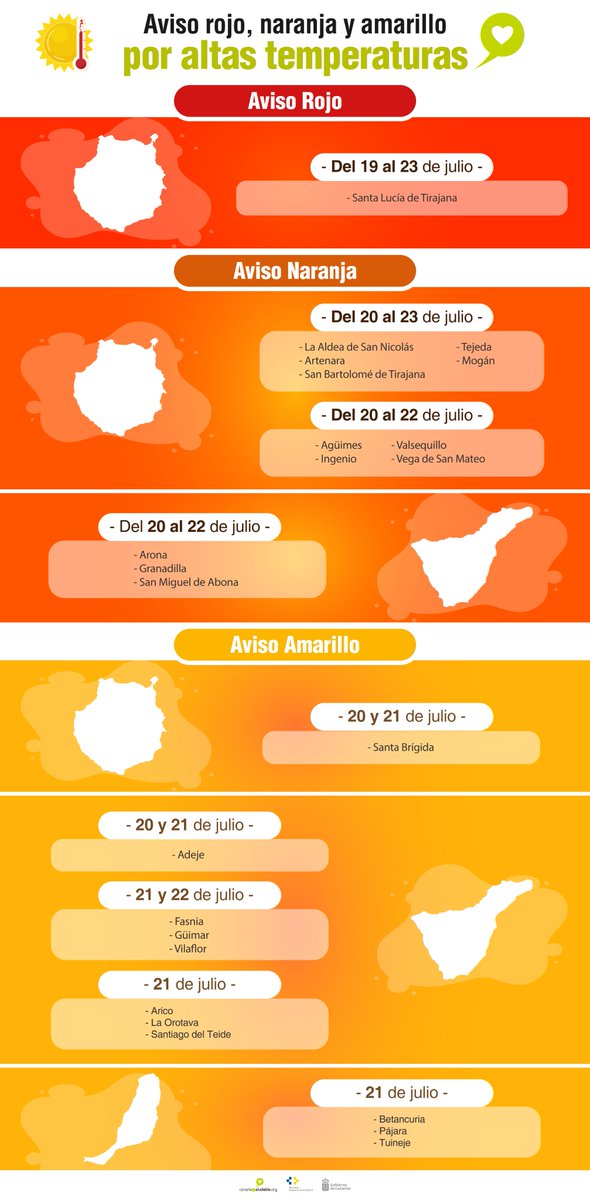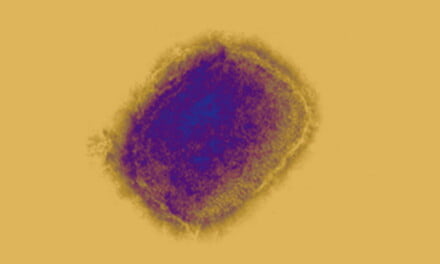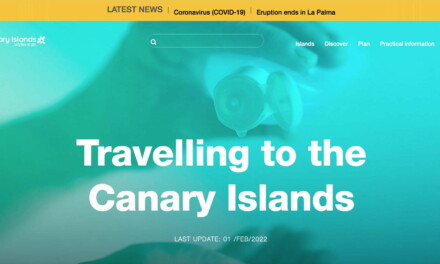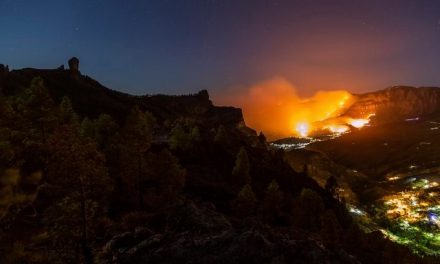A red notice has been issued for the south eastern municipality of Santa Lucía de Tirajana, on Gran Canaria. With orange notices for La Aldea de San Nicolás, Artenara, Mogán, Tejeda, San Bartolomé de Tirajana, Agüimes, Ingenio, Valsequillo and Vega de San Mateo. And a yellow notice is in force for Santa Brigida. Alerts have also been issued on Tenerife, La Palma and Fuerteventura
Red notice (high risk) :
Gran Canaria: from July 19 to 23 in Santa Lucía de Tirajana.
Orange Warning (Medium Risk) :
Gran Canaria: from July 20 to 23 in La Aldea de San Nicolás, Artenara, Mogán, San Bartolomé de Tirajana and Tejeda. From July 20 to 22 in Agüimes, Ingenio, Valsequillo and Vega de San Mateo.
Tenerife: from July 20 to 22 in Arona, Granadilla de Abona and San Miguel de Abona.
Yellow Notice (Low Risk) :
Gran Canaria: July 20 and 21 in Santa Brígida.
Tenerife: on July 20 and 21 in Adeje. On July 21 and 22 in Fasnia, Güímar and Vilaflor. On July 21 in Arico, La Orotava and Santiago del Teide.
La Palma: on July 21 in Breña Alta, Fuencaliente and Tazacorte.
Fuerteventura: on July 21 in Betancuria, Pájara and Tuineje.
The General Directorate of Public Health has issued reports to the Vice-Ministry of Social Rights of the Government of the Canary Islands and the municipalities, through the Canarian Federation of Municipalities (FECAM), detailing the areas affected by the forecast of simultaneous high temperatures, and sent reminders of the measures they must take on those days to protect the health of the most fragile members of their communities:
- Drink plenty of water or fluids without waiting to feel thirsty, unless there is a medical contraindication. Avoid alcoholic and very sugary drinks.
- Avoid exposing yourself to the sun during the hours of greatest heat intensity (between 11 a.m. and 4 p.m.), so preferably before 11 a.m. or after 4 p.m.
- In the hottest hours, place yourself in the coolest areas of the houses or residences, or, where appropriate, place ventilation or air conditioning devices, or lastly, use fresh damp cloths or take a shower.
- Avoid sports activities, excursions or visits out in the hottest hours. Carry out these activities in the early hours of the day, in the late afternoon or at night; protect yourselves from the sun and drink plenty of drinks that replace fluids and mineral salts (juices, isotonic drinks, water, etc.).
- Eat light meals that help replenish the salts lost through sweat (salads, fruits, vegetables, gazpachos or juices).
- If you have to go outside, try to be in the shade, wear light and light-coloured clothing, protecting yourself from the sun with approved hats or caps and sunglasses. Wear cool, comfortable, breathable shoes.
- Be careful with medications, especially those that must be in the refrigerator for proper storage.
- Always maintain the food cold chain.
- In the event of presenting any symptomatology associated with heat such as headaches, dizziness, cramps, general malaise, a sensation of suffocation due to heat, fatigue or exhaustion, you must contact 1-1-2.
These actions are intended to increase risk prevention capacity by applying measures that are easy and accessible. The plan is aimed at the entire population, and especially designed for the population groups most vulnerable to intense heat, such as the elderly, children and people with chronic pathologies.
All hospitals and the Canary Islands Emergency Service (SUC) have staff designated and specially trained to deal with and effectively coordinate services in the event of a possible heat wave, as well as the communication channels established for adequate surveillance.
Temperature thresholds and risk levels
 In order to establish a heat health risk warning, maximum and minimum temperatures must be reached simultaneously. These are the temperature thresholds, which are set each year by the State Meteorological Agency. For the two Canary Islands provinces the temperature threshold is 32 degrees maximum and 24 minimum.
In order to establish a heat health risk warning, maximum and minimum temperatures must be reached simultaneously. These are the temperature thresholds, which are set each year by the State Meteorological Agency. For the two Canary Islands provinces the temperature threshold is 32 degrees maximum and 24 minimum.
The Plan for the Prevention of the Effects of High Temperatures on People’s Health establishes four different levels of health risk, depending on the expected temperatures and their duration over time.
🥵Los próximos días varios municipios estarán en aviso por altas temperaturas 👇🏻 https://t.co/9dtA2TJQMf
— Sanidad Gobcan (@SanidadGobCan) July 18, 2022













